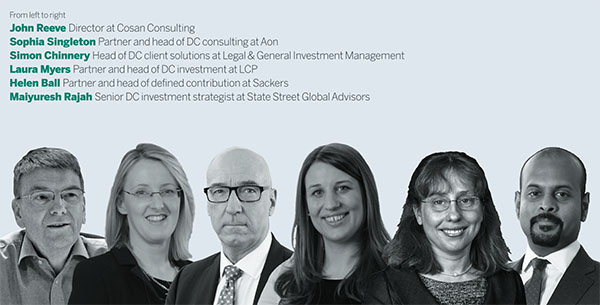Six defined contribution specialists discuss what risk means for DC investors, and whether the time is now for ETFs.

Some lifecycle and target date funds still ‘derisk’ into bonds and cash towards the end of a member’s savings journey, but are we right to consider fixed income low risk?
Laura Myers: Whether fixed income is low risk depends primarily on what the member is aiming for. Before freedom and choice, most lifecycle and target date funds would derisk members’ pots into long duration bonds to protect against the changing value of the pension product purchased at retirement, which back then was almost certainly an annuity.
This meant that these long bonds were ‘low risk’ as the changes in the bond value would reflect the change in the price of the annuity.
Changing the pension destination from cash, drawdown or annuity has surprisingly little impact on members’ outcomes
Simon Chinnery, LGIM
Since freedom and choice we have seen a significant downturn in annuity purchase and instead the key priority is protecting the absolute pot size – whether it is taken as cash or drawdown.
This means those members approaching retirement that are still invested in long bonds are likely to be taking significant duration risk, which could be very detrimental for their pot sizes if rates rise.
John Reeve: Risk can only be assessed in relation to what the member is trying to achieve. For many, fixed interest or cash investments will be anything but ‘low risk’.
Those looking to take their benefits in cash, many with small pots, will find that fixed interest will not protect the cash value. Those who are looking to continue to invest, for drawdown or phased retirement, will find that fixed interest will not offer the returns that they desire.
Having said this, for many, the real aim is to reduce volatility, although they might not realise that this is what they want. When asked, investors often refer to the risk of values going up or down or of investments “being worth less”.
This fear is natural and not something that can be easily overcome. For those who are worried about volatility, fixed interest and cash have a place.
Sophia Singleton: Historically, the derisking phase was limited to using fixed income funds, aiming to reduce risk relative to changes in annuity prices. In this context, fixed income could be considered a low risk investment.
Since the introduction of freedom and choice, many members are choosing not to purchase an annuity, so we need to think of risk differently. We now need to focus on the absolute variability of outcomes, as well as the magnitude and duration of capital loss.
Fixed income funds have not protected members effectively against capital losses, especially over recent periods. Therefore if you are saving focusing on the size of the pot at retirement, fixed income can also be a risky investment.


Helen Ball: Investments such as corporate bonds and gilts have traditionally been considered lower risk than equities.
However, they are not a perfectly ‘safe’ asset for those approaching retirement because they depend upon their counterparty’s ability to pay and, of course, come at a price.
Also, not all fixed income is of equal risk, as this will depend on the actual investments involved, so trustees must take advice to make suitable choices for their own particular scheme.
Maiyuresh Rajah: Post the freedom and choice pension reforms, most default strategies are less reliant on bonds in the retirement phase. It is more common to have a ‘keep your options open’ strategy that contains a mix of equities, diversified growth assets, and bonds – and allows a member to choose whether to access their savings as cash lump sums, drawdown or via an annuity.
The key thing in that case is the overall risk of the portfolio rather than the contribution of any single asset class. While expected returns on bonds are low and rates may rise in future, high quality government and corporate bonds still have a role to play in the retirement portfolio and can provide useful protection in certain market environments, for example, when equities are weak.
Simon Chinnery: The marginal benefits of derisking are lower than might be intuitively expected. At the margin, this should open schemes up to shorter derisking periods and potentially less derisking than if the benefits were more extreme. There is a higher expected return from growth assets such as equities relative to ‘derisking’ assets like cash or pre-retirement fund bonds.
But is it ‘right’ or ‘wrong’ to derisk to bonds? Ultimately, what matters is the investors’ retirement destination. Objectively, changing the pension destination from cash, drawdown or annuity has surprisingly little impact on members’ outcomes.
Taking the wrong derisking path is marginally worse because the member is mismatched against their at-retirement decision. Derisking a member into cash unnecessarily may have a more pronounced impact, in particular for drawdown.
Multi-asset comes in many different forms – which are right for DC?
Myers: DC schemes have typically relied heavily on equities for the growth phase of the lifecycle, although many now also use multi-asset funds as part of the growth stage allocation. A multi-asset fund that provides a broad asset exposure is likely to be most suitable as this can offer the greatest diversification benefits.
In my view, complexity is not a material driver to the choice of a multi-asset fund as most members do not need or want to understand the detail of the investment approach – that is the job of the trustees. Therefore, complex or synthetic approaches should not necessarily be discounted, particularly if they are cost effective.

Also, due to the restrictions on costs in DC, focusing on a less active approach to asset allocation is often preferred to seeking manager skill to generate returns.
Reeve: Multi-asset solutions are key to an effective strategy for many DC investors. I hope that the industry will continue to challenge what is the best way of delivering this and to come up with better and more accessible alternatives.
The argument about returns net of expenses are undoubtedly correct, but the market is not sophisticated
John Reeve, Cosan Consulting
The DC market desperately needs access to liquid, low-cost solutions – rather than ‘cost effective’ or ‘value for money’ – to give members the benefit of diversification. This includes diversification into the less accessible investment markets that they are currently largely precluded from.
It is important to realise that we are unlikely to win the debate on whether ‘costly can be good’. The argument about returns net of expenses are undoubtedly correct, but the market is not sophisticated, and the political and social environment is not conducive to winning that argument.
We need to appeal to the basic instincts of the consumer/investor for a good deal. In the current market, costs are everything.
Singleton: We need to understand the objectives of investing in multi-asset funds. We think about multi-asset funds as belonging to three broad types: growth, capital preservation and absolute return. These approaches are distinguished by their differing focus on generating returns and risk profile. Clearly the various multi-asset funds can each play a different role within a portfolio.
Multi-asset funds are able to preserve capital and offer inflation-plus returns, and so are a useful tool in the later stages of a member’s career, when the focus is on managing variability and capital loss.
Conversely, projected returns for multi-asset funds relative to equities have decreased, and an allocation to multi-asset funds early on might hinder members from achieving the required returns.
Ball: Multi-asset investments cover a wide field and, as with any DC investment strategy, what is appropriate will depend on the trustees’ objectives, for the default option, and the individual’s objectives, for self-select options.
These days, attention is more likely to focus on multi-asset fees and performance rather than their legal structure. For example, it is not unusual for the charge cap on default arrangements to influence the type of multi-asset arrangement that trustees can ‘afford’.
Given that a multi-asset strategy tries to generate returns in different market conditions, without correlation to equities, it is sometimes considered an appropriate higher-risk element of a DC scheme’s default option.
Rajah: Most DC default investment strategies may benefit from including a multi-asset fund that provides a wide range of asset class exposures, adapts its asset mix dynamically to target the right assets for current market conditions, and is delivered at relatively low cost, for example by achieving its asset class exposures via low cost index funds.
In addition, from an operational perspective, the right multi-asset fund for DC would be one that does not break the charge cap and satisfies the daily trading requirements of the fund platforms that the scheme is using. Ideally, the manager’s strategy will also be relatively intuitive and easy to communicate to scheme members.
Chinnery: Diversification is a key benefit but multi-asset investing is a broad church with many different interpretations of ‘the way’. For instance, Nobel prize-winning economist Harry Markowitz famously outlined the classic quantitative approach ‘mean-variance optimisation’. This approach characterises asset classes purely by their expected returns, and the historical volatility and correlation between them.
There is also ‘risk parity’; an approach that links asset allocation exclusively to the efficient allocation of portfolio risk. At its core, it argues that portfolios need to balance their risk exposure between underlying building blocks or risk drivers, and maximise diversification.
DC investors generally dislike risk, so it is no surprise that so many have embraced diversification. It spreads out investment exposures and can reduce the chance of really bad outcomes. As such, it is often called one of the few ‘free lunches’ in investments; an opportunity to reduce risk without impacting the expected return.
But as investors have found out over the past few years, it can feel quite painful to miss out on the returns that, with the benefit of hindsight, a more concentrated portfolio would have given.
However, it is important to remember that most DC members are in a default solution, so the attractions of a smoother glide over multiple years is a reasonable trade-off for many.
How useful are exchange-traded funds for DC schemes?
Myers: ETFs have so far been little used in DC schemes primarily due to the cost of holding them over the long term and tactical asset allocation being delegated to investment managers.
However, I can see ETFs becoming more popular in DC schemes particularly to manage trading costs when building a bespoke diversified portfolio or to gain exposure to more niche sectors and assets.
Historically ETFs have been dismissed as it has been cheaper to access the same indices through institutional index-tracking funds, but over the last few years there has been significant growth in assets in ETFs and this has reduced costs, so now would be a good time for DC schemes to look again.
ETFs are notoriously difficult to access; few are life-wrapped by managers
Sophia Singleton, Aon
Reeve: ETFs would seem to be ideal for DC schemes given their high liquidity and low costs. However, as with any investment, it is important that the investor knows what they are buying and the risks involved.
Most ETFs would appear to manage risks efficiently and effectively.
Providers and employers would probably be well advised to avoid those which use a leveraged or geared approach due to the difficulty of communicating this effectively.
However, a basic ETF is an efficient way of getting exposure to an index for any investor.
Singleton: Theoretically, ETFs could be useful for providing members with access to niche areas and catering for engaged members who demand access to specific industries or regions.
In practice, the direct use of ETFs in DC schemes is limited. There are two key issues with ETFs in their current form which limits their usefulness for DC schemes.
One is that the fees for ETFs can be several multiples higher than traditional index funds, which is difficult to justify in terms of additional value to members.
Secondly, ETFs are notoriously difficult to access; few are life-wrapped by managers.
Trustees focus on addressing membership needs as a whole, and incorporating ETFs may be contradictory to offering a concise fund range; members who wish to invest in specialist funds can do so via an alternative savings vehicle.
Ball: ETFs are intended to provide liquidity and that is always attractive for DC schemes. However, the use of such funds remains rare in practice.
Rajah: ETFs are excellent for gaining exposure to asset classes quickly and cheaply if the scheme has a view on future market direction that it would like to take advantage of promptly.
However, as most schemes include asset classes in their investment strategy with an eye for the long term, unless there is a cost advantage of using an ETF or availability of other pooled funds is an issue, it may make sense to use an institutional index fund instead.
In addition, relatively few DC platforms are currently able to invest in ETFs directly, though some are developing means of access.
Chinnery: As ETFs continue to evolve, with costs falling and usage increasing, they are becoming an attractive alternative for many individual investors. Over time, we expect demand for equity, fixed income and factor-based ETFs to accelerate alongside their index fund equivalents as institutions become more wrapper agnostic.
We would expect the use of ETFs in DC schemes to grow over time as a potential alternative in multi-asset solutions that currently use index funds, as well as being part of the investment choice on platforms.
Click here to read part 2 on mastertrust selection and lessons from abroad














